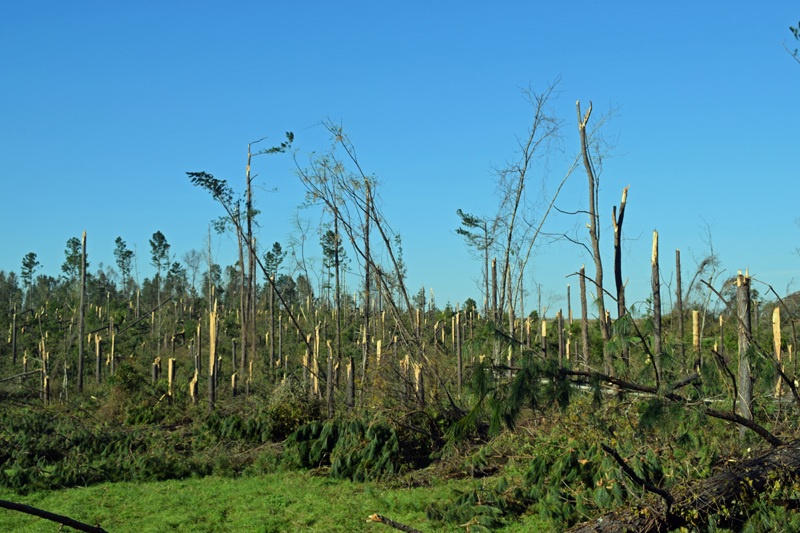–
It has been over two years since Hurricane Michael devastated the Central Panhandle. In that time tremendous strides have been made towards patching our part of the world back together. Some of the landscape is getting back to normal, but in some areas the destruction is still very visible. This is particularly true of our forested lands.
The amount of time, effort, and money necessary to restore forests throughout the area will be staggering. To help facilitate these restoration efforts the USDA Farm Service Agency administers the Emergency Forest Restoration Program (EFRP). EFRP provides cost-share dollars to help the owners of nonindustrial private forest land to off-set costs associated with clean-up, tree planting, and other steps necessary to bring forest lands back to productivity.
Land owners had the opportunity to sign-up for EFRP shortly after Hurricane Michael. For land owners who have not already signed-up, the sign-up period has been re-opened until March 11, 2021. Contact your local FSA office to sign-up or for more information. Additional details about EFRP are included in the following FSA press release:
U.S. Department of Agriculture (USDA) Farm Service Agency (FSA) in Florida announced that counties are accepting applications for the Emergency Forest Restoration Program (EFRP) to address damages from Hurricane Michael that occurred in 2018. The EFRP sign-up period reopened on Jan. 19, 2021 and ends on March 11, 2021.
–
EFRP provides payments to eligible owners of nonindustrial private forest (NIPF) land to restore land damaged by a natural disaster. Before an application for EFRP assistance is approved, an onsite inspection of the damages by FSA, in cooperation with a state forester, is required to verify the damages from Hurricane Michael.
–
Counties that received presidential disaster designations following Hurricane Michael will be eligible. Foresters in Bay, Calhoun, Dixie, Franklin, Gadsden, Gulf, Holmes, Jackson, Jefferson, Lafayette, Leon, Liberty, Madison, Taylor, Wakulla, Walton, Washington can apply for EFRP cost-share assistance through their local USDA Service Center.
–
“FSA remains committed to helping producers impacted by Hurricane Michael,” said Christy Marshall, Acting State Executive Director in Florida. “I encourage eligible producers to contact their county office as soon as possible to make an appointment to apply.”
–
To meet eligibility requirements, NIPF land must have existing tree cover or had tree cover immediately before Hurricane Michael occurred and be sustainable for growing trees. The land must also be owned by any nonindustrial private individual, group, association, corporation or other private legal entity that has definitive decision-making authority over the land.
–
For more information on EFRP, please contact your local FSA county office or visit https://www.farmers.gov/recover. To find your local office, visit farmers.gov/service-center-locater. Source: https://www.fsa.usda.gov/state-offices/Florida/
–
Eligible Forest Restoration Practices
To restore NIPF, EFRP participants may implement emergency forest
restoration practices, such as:
- Debris removal, such as down or damaged trees, in order to establish a new stand or provide for natural regeneration
- Site preparation, planting materials, and labor to replant forest stand
- Restoration of forestland roads, fire lanes, fuel breaks, or erosion control structures
- Fencing, tree shelters, and tree tubes to protect trees from wildlife damage
- Wildlife enhancement to provide cover openings and wildlife habitat.
–
EFRP Cost-Share Payments
Up to 75 percent of the cost to implement approved restoration practices. Limited to $500,000 per person or legal entity per disaster.
–
More Information
EFRP Fact Sheet (printable)
USDA EFRP Website
- Peanut Maturity Update – 10/9/25 - October 10, 2025
- Fall Can be a Great Time for Vegetation Management - October 3, 2025
- Peanut Maturity Update – 9/25/25 Edition - September 26, 2025

